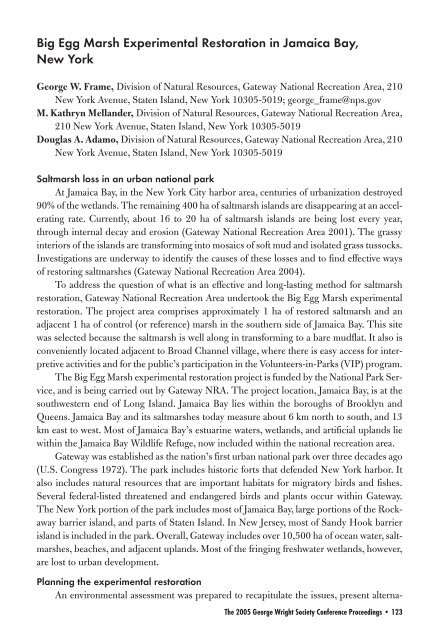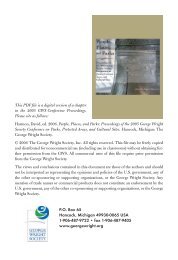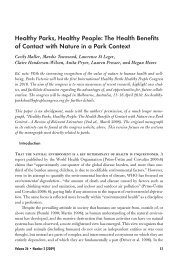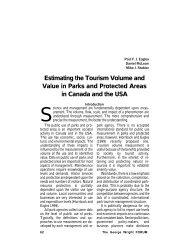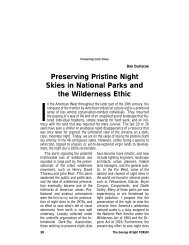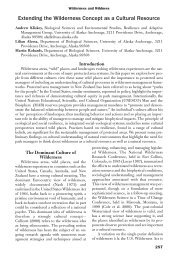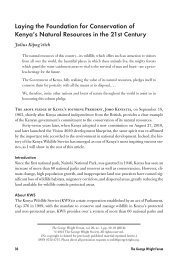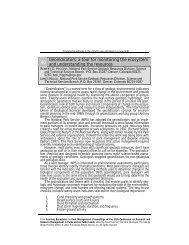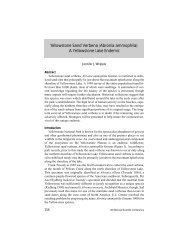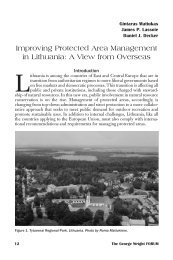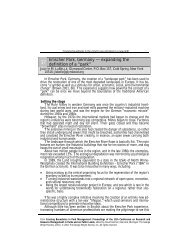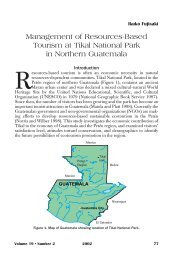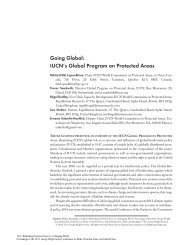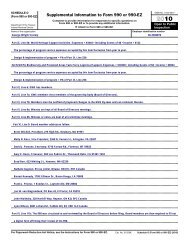Big Egg Marsh Experimental Restoration in Jamaica Bay
Big Egg Marsh Experimental Restoration in Jamaica Bay
Big Egg Marsh Experimental Restoration in Jamaica Bay
You also want an ePaper? Increase the reach of your titles
YUMPU automatically turns print PDFs into web optimized ePapers that Google loves.
<strong>Big</strong> <strong>Egg</strong> <strong>Marsh</strong> <strong>Experimental</strong> <strong>Restoration</strong> <strong>in</strong> <strong>Jamaica</strong> <strong>Bay</strong>,<br />
New York<br />
George W. Frame, Division of Natural Resources, Gateway National Recreation Area, 210<br />
New York Avenue, Staten Island, New York 10305-5019; george_frame@nps.gov<br />
M. Kathryn Mellander, Division of Natural Resources, Gateway National Recreation Area,<br />
210 New York Avenue, Staten Island, New York 10305-5019<br />
Douglas A. Adamo, Division of Natural Resources, Gateway National Recreation Area, 210<br />
New York Avenue, Staten Island, New York 10305-5019<br />
Saltmarsh loss <strong>in</strong> an urban national park<br />
At <strong>Jamaica</strong> <strong>Bay</strong>, <strong>in</strong> the New York City harbor area, centuries of urbanization destroyed<br />
90% of the wetlands. The rema<strong>in</strong><strong>in</strong>g 400 ha of saltmarsh islands are disappear<strong>in</strong>g at an accelerat<strong>in</strong>g<br />
rate. Currently, about 16 to 20 ha of saltmarsh islands are be<strong>in</strong>g lost every year,<br />
through <strong>in</strong>ternal decay and erosion (Gateway National Recreation Area 2001). The grassy<br />
<strong>in</strong>teriors of the islands are transform<strong>in</strong>g <strong>in</strong>to mosaics of soft mud and isolated grass tussocks.<br />
Investigations are underway to identify the causes of these losses and to f<strong>in</strong>d effective ways<br />
of restor<strong>in</strong>g saltmarshes (Gateway National Recreation Area 2004).<br />
To address the question of what is an effective and long-last<strong>in</strong>g method for saltmarsh<br />
restoration, Gateway National Recreation Area undertook the <strong>Big</strong> <strong>Egg</strong> <strong>Marsh</strong> experimental<br />
restoration. The project area comprises approximately 1 ha of restored saltmarsh and an<br />
adjacent 1 ha of control (or reference) marsh <strong>in</strong> the southern side of <strong>Jamaica</strong> <strong>Bay</strong>. This site<br />
was selected because the saltmarsh is well along <strong>in</strong> transform<strong>in</strong>g to a bare mudflat. It also is<br />
conveniently located adjacent to Broad Channel village, where there is easy access for <strong>in</strong>terpretive<br />
activities and for the public’s participation <strong>in</strong> the Volunteers-<strong>in</strong>-Parks (VIP) program.<br />
The <strong>Big</strong> <strong>Egg</strong> <strong>Marsh</strong> experimental restoration project is funded by the National Park Service,<br />
and is be<strong>in</strong>g carried out by Gateway NRA. The project location, <strong>Jamaica</strong> <strong>Bay</strong>, is at the<br />
southwestern end of Long Island. <strong>Jamaica</strong> <strong>Bay</strong> lies with<strong>in</strong> the boroughs of Brooklyn and<br />
Queens. <strong>Jamaica</strong> <strong>Bay</strong> and its saltmarshes today measure about 6 km north to south, and 13<br />
km east to west. Most of <strong>Jamaica</strong> <strong>Bay</strong>’s estuar<strong>in</strong>e waters, wetlands, and artificial uplands lie<br />
with<strong>in</strong> the <strong>Jamaica</strong> <strong>Bay</strong> Wildlife Refuge, now <strong>in</strong>cluded with<strong>in</strong> the national recreation area.<br />
Gateway was established as the nation’s first urban national park over three decades ago<br />
(U.S. Congress 1972). The park <strong>in</strong>cludes historic forts that defended New York harbor. It<br />
also <strong>in</strong>cludes natural resources that are important habitats for migratory birds and fishes.<br />
Several federal-listed threatened and endangered birds and plants occur with<strong>in</strong> Gateway.<br />
The New York portion of the park <strong>in</strong>cludes most of <strong>Jamaica</strong> <strong>Bay</strong>, large portions of the Rockaway<br />
barrier island, and parts of Staten Island. In New Jersey, most of Sandy Hook barrier<br />
island is <strong>in</strong>cluded <strong>in</strong> the park. Overall, Gateway <strong>in</strong>cludes over 10,500 ha of ocean water, saltmarshes,<br />
beaches, and adjacent uplands. Most of the fr<strong>in</strong>g<strong>in</strong>g freshwater wetlands, however,<br />
are lost to urban development.<br />
Plann<strong>in</strong>g the experimental restoration<br />
An environmental assessment was prepared to recapitulate the issues, present alterna-<br />
The 2005 George Wright Society Conference Proceed<strong>in</strong>gs • 123


